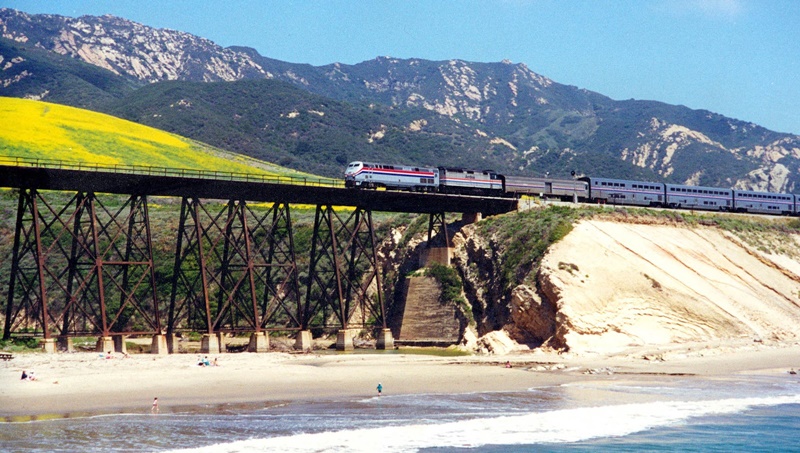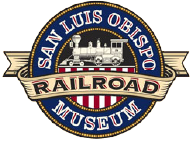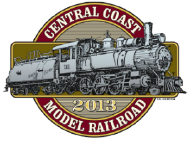Another Seven Years to Close “The Gap”
After the ceremony marking completion of the railroad from San Francisco to San Luis Obispo in May 1894, construction proceeded south. Also, work continued on buildings and on the yard, turntable, and roundhouse, whose sites required significant earthmoving. By the end of the year, graders had moved across the Santa Maria River and were approaching Guadalupe.
By January 14, 1895, track was completed to the edge of Pismo, and on July 1 regular trains began running over the Santa Maria River on a temporary wood trestle, later replaced by a 1,283-foot steel structure, into Guadalupe.
By June 10, 1896, the gap on the Coast Line had been narrowed to 56 miles between Surf and Elwood; but progress on this final section was not immediately forthcoming. This would be a costly piece of railroad to construct, involving heavy fills, two tunnels, and nine steel trestles. Poor financial conditions and maturing debt obligations diverted capital from the Coast Line project.
Yet there was an increase in passenger traffic. Due to the heat in the Central Valley, many passengers traveling from San Francisco to Los Angeles began taking a train to Surf, then a stage to Santa Barbara, and a train to Los Angeles. Others would get off at San Luis Obispo and take the Pacific Coast Railway to Los Olivos, then the stage to Santa Barbara. The resulting journey was considerably slower but cooler.
Finally, in November 1898, with financial conditions improving and the company’s debt crisis resolved, work on the extension was resumed at Surf.
Track was laid to Honda by mid December 1898, although the viaduct across the Cañada Honda was not ready until the end of July 1899. Meanwhile, graders were at work further down the line, including the 811-foot tunnel near Sudden, so that once the viaduct at Honda was opened, track laying proceeded rapidly.
For several years, the company had been content to intermittently pursue the construction of the Coast Line from the north, extending it southward as conditions would permit. But in the spring of 1899, in order to hasten the completion of the Coast Line, it was decided to work from both ends of the gap.
On March 27, 1899, graders began work on an entirely new alignment that straightened out many of the curves on either side of the station at Ellwood before setting out into new territory in the direction of Gaviota. By October, there were over 1,000 men at work along the line engaged in filling some of the immense canyons draining into the sea and spanning others with large steel viaducts.
In January 1900, the 451-foot bridge across the canyon at Jalama Creek was completed, as was Tunnel 13, five miles west of Gaviota. On March 15, after a 12-year lapse, track laying from the south resumed at Ellwood. By April, Southern Pacific was accepting commercial freight as far south as Concepcion. In May the 661-foot Dos Pueblos Canyon Bridge was completed. By June 30, all that remained was a gap just shy of 18 miles between Cuarto Canyon and Gato Canyon.
Work continued steadily. The 634-foot Alegria Canyon Viaduct was completed in September, and the 61-foot Refugio Creek Bridge in October. The 541-foot Arroyo Hondo Bridge was finished on December 30, 1900, the last rail was laid, and the last spike driven about one mile east of Gaviota.
The line was not opened immediately for service. Track had to be ballasted and surfaced, buildings and water facilities erected, and a multitude of other details worked out before operations could commence.
On Sunday, March 31, 1901, more than thirty-six years since the first rails were laid in San Francisco, the goal of linking Los Angeles and San Francisco by rail via the Coast Line had finally been achieved. It had been a long time coming, and the coastal counties that the completed line served now looked forward to a prosperous new era.
Southern Pacific, however, was far from through with its Coast Line construction work. Once the Coast Line was completed and through trains were running, it was quickly realized that the route had a number of physical limitations that prevented the exploitation of the line to the fullest extent. The main projects to ease the entry to the San Fernando Valley, the Santa Susana Tunnel and Montalvo Cutoff, would come later.”


